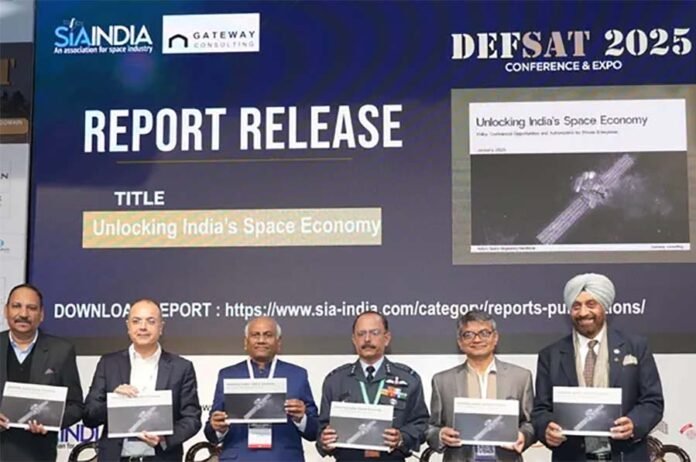New Delhi. Witnessing an exceptional turnout, the inaugural day of DefSat 2025, set the stage for India’s ambitions to accelerate its defence space modernisation. The opening day of three-day event (January 8-10, 2025), being held at the Manekshaw Centre, New Delhi saw in attendance a large number of eminent delegates from government, defence, space, technology, homeland security, and international embassies.
Emphasising the role of disruptive space technologies in transforming modern warfare across land, maritime, aerospace, cyberspace, and homeland security, the DefSat 2025 brings together thought leaders and innovators under the theme “Integrated Space Capabilities for Multi-Domain Operations.”
The inaugural session of the three-day conference was addressed by Lt Gen PJS Pannu (retd); Viasat India Managing Director Gautam Sharma; Data Security Council India CEO Vinayak Godse; President SIA-India and CMD Ananth Technologies Subba Rao Pavuluri.
In his welcome address, Dr Subba Rao Pavuluri, President, SIA-India, and CMD, Ananth Technologies, remarked, “DefSat 2025 arrives at a pivotal moment as India accelerates its space growth trajectory and defence modernisation, with these sectors expected to grow at a 14–16% CAGR. Space technology is now indispensable in defence strategies, a reality reflected in the Rs 25,000 crore allocated for Defence Space Investments and Rs 23,855 crore for DRDO in FY 2024-25.”
In a first, DefSat 2025 highlights the convergence of space technology and homeland security, paving the way for a safer and interconnected future.
Lt Gen (Dr) PJS Pannu (retd), stated, “Space is a critical multiplier in modern military strategy, and understanding the OODA Loop (Observe, Orient, Decide, Act) is paramount in both space and terrestrial conflicts. The militarisation of space demands swift and strategic decision-making.”
During the conference, an MoU between Data Security Council of India (DSCI) and SIA-India was exchanged. Aligned with SIA-India and DSCI’s vision, the partnership aspires to drive innovation, capacity building, and policy reforms, securing India’s space communication ecosystem. The MoU aims at – Strengthening satellite communications; Advancing specialised skill-building; Promoting cybersecurity in the Indian space industry and Conducting market research and fostering collaborations.
“India has set global benchmarks in the democratisation of digital transactions. Now, it is time to democratise cybersecurity. With private players entering the fray, India is positioned to become a global hub for secure and resilient digital ecosystems,” said Vinayak Godse, CEO of DSCI.
DefSat 2025 also marked the launch of the Space Economy Handbook, jointly released by SIA-India and Gateway Consulting in the presence of Dr Subba Rao Pavuluri, President, SIA-India, Lt Gen (Dr) PJS Pannu (retd), Senior Advisor, SIA-India, AVM Pawan Kumar, DG, Defence Space Agency, Vinayak Godse, CEO, DSCI and Gautam Sharma, MD, Viasat India.
Highlighting regulatory frameworks, commercial opportunities, and private sector authorisations, the handbook offers a comprehensive overview of India’s evolving space sector, serving as a key resource for global stakeholders eyeing India’s vibrant industry.
In the inaugural address at the DefSat 2025 conference, AVM Pawan Kumar, DG – Defence Space Agency said, “When you talk of communication, I think the technology that we are focusing on is integrated satellite communication grid. We don’t want any service to be over dependent on a particular satellite.”
Reflecting on the strategic importance of satellites in modern warfare, AVM Pawan Kumar, DG, Defence Space Agency, said that the defence forces were also looking at collaborating with the industry to meet its requirements to get an edge over its rivals in the domain.
Referencing the Russia-Ukraine conflict as the first “space war”, AVM Pawan Kumar emphasised on the need for resilience in defence space capabilities.
He said the defence forces were looking at a mix of constellations, either Medium Earth Orbit (MEO)-Geostationary Orbit (GEO) or Low Earth Orbit (LEO)-MEO-GEO, and a lot of studies have happened on that. “We are also looking at tracking and data relay satellite systems primarily because it reduces demand to delivery time as far as OODA loop is concerned,” he added.
Pointing that the defence forces were also exploring quantum communications because of the obvious advantages of secrecy, AVM Pawan Kumar said, “We are looking for space and ground-based sensors which include telescopes and radars, along with the complete network so that the commanders can make appropriate decisions, whether it is military level, operational level, or tactical level.”
Another key highlights of Day 1 included sessions on AI-Enabled Mosaic Warfare, Space-Powered Maritime Strategies, and Military-Grade Certification Standards for the Defence Space Sector.
In his vote of thanks address, Anil Prakash, Director General , SIA -India said, “The Indian space industry has matured through its collaboration with ISRO’s strategic missions, with platforms like DefSat showcasing its capabilities. Now, the industry is ready to take the next leap—working hand in hand with defence, homeland security, and global stakeholders to drive innovation, resilience, and strategic advantage.”
Industry leaders including Ananth Technologies, Planet Labs, Safran, GalaxEye, Dhruva Space, and ReOrbit are participating in DefSat 2025 Exposition. The event has received robust support from key entities such as NSIL, DRDO, Ministry of Defence, Aeronautical Society of India, and RIS. At the event, the presence of companies like Safran, Planet Labs, C2C Advanced Systems, and Ananth Technologies through their exclusive technical showcases will help in fostering collaboration between startups and established players.
Raksha Anirveda's editorial desk team brings in the collective experience of creative professionals - a fine mix of senior copy editors, writers, proofreaders and designers. Working as a team, they continuously create, manage, and curate content to sustain the magazine's profile and reputation in line with market trends and achieve magazine's goal.





